Content
- 1 We grow garden sage in the country and select a favorable neighborhood for it
- 2 Features of the genus
- 3 Sage: species and cultivation (briefly)
- 4 Sage: planting and care in the open field (general information)
- 5 Getting seedlings
- 6 Planting seedlings in the ground
- 7 Planting in open ground with seeds
- 8 Care features
- 9 Preparing for winter and hibernation
- 10 Breeding methods for sage
- 11 Sage in the country: two ways of planting and care
- 12 Planting sage
- 13 Sage care
- 14 Sage picking
- 15 Sage species
- 16 Sage varieties
From the practice of natural farming, we know that when we grow sage in the country, the plant should choose a favorable neighborhood. Rather, you need to check that his phytoncides do not crush their companions in the garden. After all, any spicy herbs have the so-called alelopathicity. Let's see if sage is so depressing in the garden, as they say about it.
We grow garden sage in the country and select a favorable neighborhood for it
It just so happened that we did not immediately find a place and agricultural technology for him in our garden. Either he too fell into the shadows and ran away from the site, then he got out in the winter, then he visited the mixborder for 3 seasons and disappeared again. Therefore, the need has ripened to understand his character and share with you my observations.
Sage: plant description
Sage is a perennial herb that looks like a low, squat shrub (50–75 cm), usually slightly larger in width than in height. Its soft, gray-green foliage can decorate almost any garden. Sage is often planted in flowerpots along with a variety of aromatic herbs such as rosemary, basil, and many others, preferably from the Mediterranean.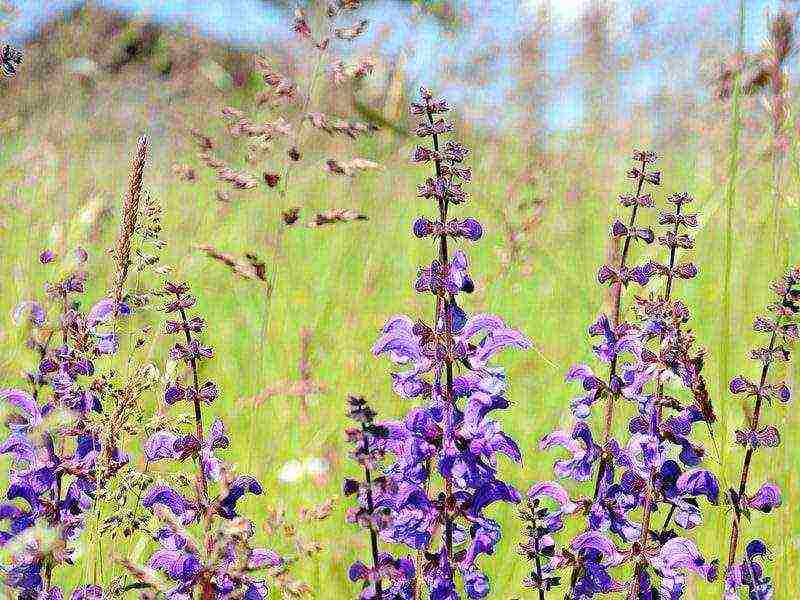
Such herbs are able to create a bouquet of exquisite aromas that make walks and rest among the greenery of the garden much more pleasant. Small flowers on inflorescences attract nectar-bearing insects to the garden, and dried tops uncut in winter become a shelter for wintering entomophages. It is quite possible to do without cutting off the faded inflorescences - dried corollas rise beautifully above the snow cover and in mixed mixborders are just as good as ornamental cereals.
As for other advantages of sage, chefs highly value its peculiar taste, as well as an exceptionally pleasant aroma. Gardeners and landscape designers are happy to use this small shrub for their work - thanks to its velvety, always green leaves and delicate flowers, it perfectly decorates the site. But we will turn to decorative forms a little later, now we will focus mainly on the so-called "edible". There are many interesting varieties on sale, here are some of them:
|
|
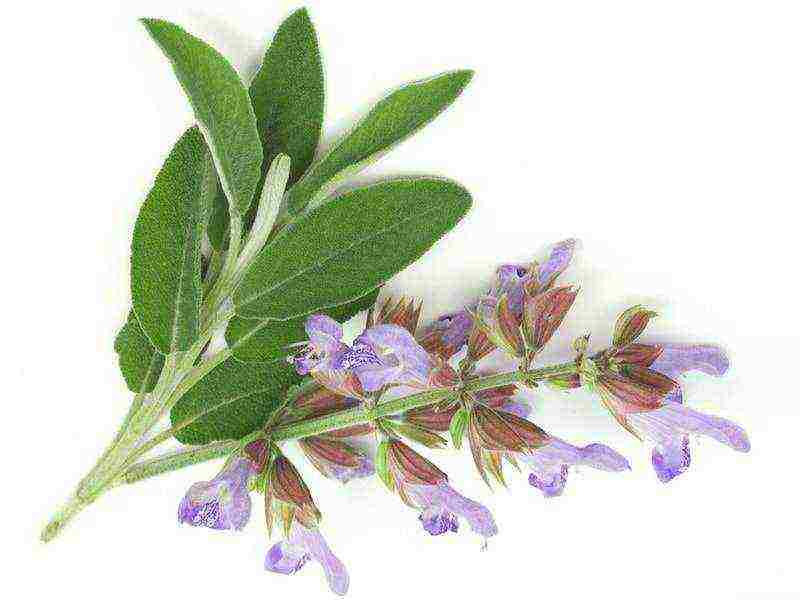
Sage officinalis: planting and care, soil requirements
In gardening and parks, varieties derived from medicinal sage are mainly used. In Russian conditions, characterized by zones of frost resistance 4–7 (minimum temperatures –12… 34 ° C), this plant is seasonal. A transplant is recommended in spring or autumn. The place should be sunny, well lit with well-drained, light soil with a pH of 6.5–7. This is achieved by adding sand and humus / compost. The desired acidity is obtained using chalk, ground eggshell or dolomite flour.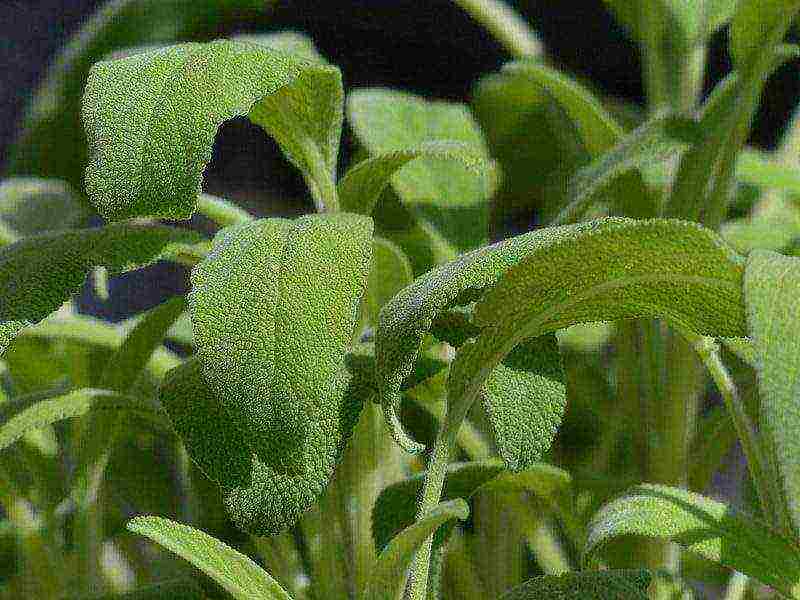
Sage, like lavender, needs to be pruned annually.This should be done in the spring, cutting off old foliage and stems. Several new ones appear in their place, which increases the bushiness of the plant. Small pink or purple flowers should appear by the end of spring. But, despite pruning, after 3-5 years sage stalks will most likely become stiff, after which it stops developing. Before the expiration of this period, it is advisable to plant young plants, which will gradually replace the old ones. They are simply cut and placed in water, where in a month they give good roots: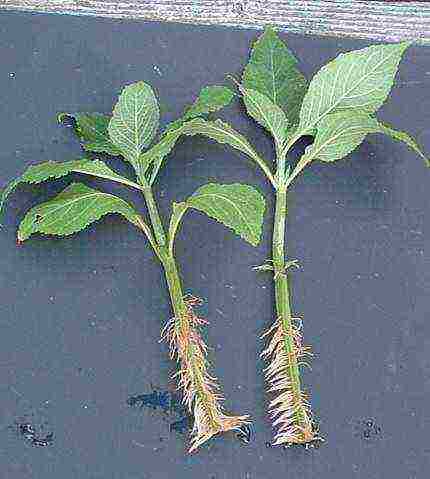
Sage in the garden and its companions
In nature, sage grows in dry places, next to plants such as letter, cereals and irises. Therefore, in garden flower beds, it is necessary for him to select fairly drought-resistant neighbors. It can also be planted around the perimeter of the garden, sage improves the taste of strawberries, and drives away cabbage butterflies from cabbage. But cabbage is moisture-loving, so the sage bush should be planted away from watering - again, on the periphery of the garden.
Problems
Of the diseases for sage, the most dangerous is mold, which can occur due to excessive thickening of the bush. To do this, it should be thinned a little in order to ensure better air circulation. This is especially important on hot, humid summer days. To reduce the amount of moisture under the bush, it would be good to lay out the space around with small stones - water evaporates faster from their surface, and the excess goes into the soil.
Collection and storage
Medicinal sage has leaves and flowering tops. And in the first year, sage collection should be done in a sparing mode, trying to cut off fewer leaves and not touch the branches. In subsequent years, you can already remove the maximum yield, up to the complete cutting of the entire bush. But to give the plant time to acquire new normal leaves, the last harvest should be carried out no later than two months before the first frost. It is advisable to dry the leaves directly with the branches, hanging them by the base, and after that they are separated and stored, as mentioned earlier, in an airtight container.
Application
The scope of sage is quite wide. In cooking, these are pork, poultry, game dishes, sausages, as well as a variety of vegetable salads, snacks and pickles. Sage is ideal as an ingredient in various herbs and spices. In addition, it is used in medicine for the treatment and prevention of diseases of the oral cavity.
Usually, those who separately create spicy beds do not have problems with growing - many spices are quite drought-resistant and photophilous. But those who like combined planting will have to experiment, since there is no consensus about companions and cannot be - everyone has different conditions on the site and the set of crops also varies greatly. But now we quite easily grow sage in the country, choosing a favorable neighborhood for them from light-loving cereals and renewing the bushes in time.
Today, according to the database of a joint project of two world-renowned organizations involved in the systematization and description of plants (Royal Botanic Gardens, Kew, United Kingdom and the Missouri Botanical Gardens, USA), called The plant list, 986 species of sage grow on the globe. ...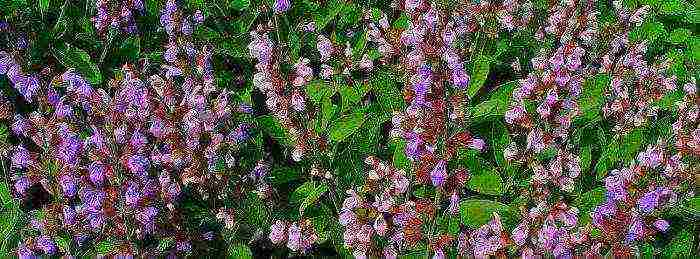
Features of the genus
The Latin name for sage is Salvia. It is a perennial plant of the Lamiaceae family. In Russia, it is traditionally divided into salvia and sage. The former belong to ornamental plants that are cultivated in annual crops.
Salvia varieties (natural and hybrid) are sold by seed. They are sown for seedlings in February-March in planting boxes. Then there is a picking and planting of seedlings in individual containers. Disembarkation is carried out around the beginning of June, after the threat of return frosts has been removed. Salvia blooms (almost all varieties) from four months of age until the end of the summer season. Decorativeness is created in various shades of colors - from purple to scarlet.
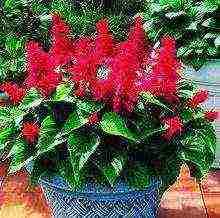
Sage is grown as a perennial plant, well known both in Europe and in all other parts of the world. Since it is not difficult to grow sage, it is customary in the gardening of different climatic regions to cultivate their own species, tested by time, medicinal and culinary experience.
Sage: species and cultivation (briefly)
Most often, the plant is associated with medicinal use. Its main type is called medicinal sage (Sālvia officinālis).
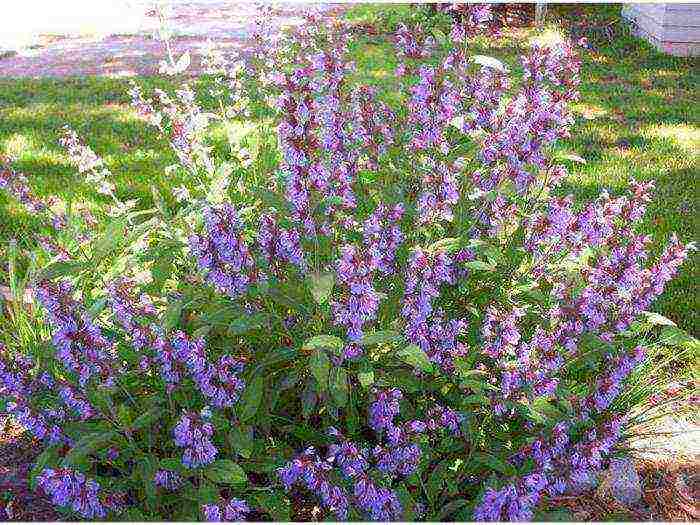 Historical use is varied: tinctures are used as an antiseptic for diseases of the gums and teeth, in the form of douching - for female problems, aromatic oils - for respiratory diseases, decoctions - for diseases of the gastrointestinal tract. Modern pharmaceuticals use Sālvia officinālis as part of a variety of drugs. The cultivation of medicinal sage is within the power of any gardener, its decorative qualities help to decorate summer cottages.
Historical use is varied: tinctures are used as an antiseptic for diseases of the gums and teeth, in the form of douching - for female problems, aromatic oils - for respiratory diseases, decoctions - for diseases of the gastrointestinal tract. Modern pharmaceuticals use Sālvia officinālis as part of a variety of drugs. The cultivation of medicinal sage is within the power of any gardener, its decorative qualities help to decorate summer cottages.
Clary sage (Salvia sclarea) is ubiquitous, often growing as a weed. Its use is associated with a specific aroma of essential oil, reminiscent of the aroma of orange and bergamot. The distillery and culinary industries use it to give products a nutmeg aroma.
Meadow sage (Salvia pratensis) grows on slopes, including stony ones, and is distributed throughout Europe. Its dried leaves are used in cooking as a seasoning for salads, soups, broths. Included in homemade marinade.
Desert sage (Salvia deserta) in Russia grows on the slopes of Altai. Among other wild species, it is of particular value as an outstanding melliferous plant.
Oak sage (Salvia nemorosa) is also Moldavian, it is also Yaylinsky sage. Growing in the country as an ornamental and melliferous plant is associated with some difficulties. The fact is that historically it is cultivated as thermophilic. Intolerance to winters with little snow and susceptibility to freezing are the distinctive qualities of oak sage. Planting and leaving in the open field in the middle zone of the Russian Federation is not difficult. A shelter before winter is a rather difficult and laborious agrotechnical process for this species.
Sage: planting and care in the open field (general information)
The cultivation of a plant has features associated with the historical origin of each species. Growth area - almost all natural zones. Growing sage on personal plots is interesting from the point of view of obtaining an ornamental fragrant honey plant, which also has medicinal and culinary features.
The fruits of almost all sage varieties are triangular rounded nuts from 1.5 to 3 mm. Sold for gardeners from producers - seed nurseries. Growing sage from seeds is not difficult, even the most inexperienced gardener can handle this (the process technology can be read below). It is much more difficult to preserve this plant for the second and subsequent years in the conditions of little snow and rather severe winters of the middle zone of the Russian Federation.
All types of sage are undemanding to the mechanical composition of the soil: loams with introduced humus and lime are suitable for them. But heavy clay soils with poor water permeability are the reason for sage freezing and rotting in the summer wet period. For the spring planting of a plant, it is enough to prepare a site for cultivation in advance by adding humus humus in the fall, before the sage planting season.
The rules for growing an adult bush dictate a fairly tough approach to the location and distances to other plants. A site for sage should be chosen so that the plant is close to the garden paths. Otherwise, its scent will be unavailable. At the same time, the plant requires shelter for the winter (albeit not the same as for a vine), therefore, it is inappropriate to place it near the house, where paths from snow will be cleared or icicles will melt.
A site for sage should be chosen so that the plant is close to the garden paths. Otherwise, its scent will be unavailable. At the same time, the plant requires shelter for the winter (albeit not the same as for a vine), therefore, it is inappropriate to place it near the house, where paths from snow will be cleared or icicles will melt.
Sage bushes with timely feeding and watering can grow up to a meter in height, their width for the second and subsequent years will increase from half a meter in diameter.
Getting seedlings
Since it is easiest to grow sage from seeds in the middle zone of the Russian Federation by seedling, therefore, the main efforts of the gardener should be focused on these works. 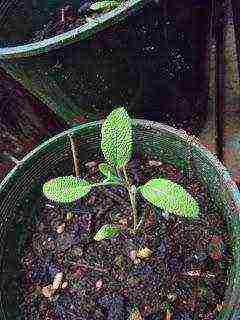 It is advisable to start dealing with planting material already in February-March. You can read about how to grow sage from seeds by direct planting in the ground below.
It is advisable to start dealing with planting material already in February-March. You can read about how to grow sage from seeds by direct planting in the ground below.
Seeds should be soaked in warm water for a day before planting. Then rinse the bag in a pink solution of potassium permanganate for disinfection. Seeds prepared in this way can be sown in a seed box, seeding them to a depth of no more than 1.5 mm. Close the box with glass or plastic, place in a warm place (20-25 degrees Celsius). Ventilate periodically, opening for 5-20 minutes, to additionally check for moisture and mold.
In two to three weeks, sprouts will appear. The glass must be removed, the box must be placed in a lighted room. Best of all - next to the radiator, under the windowsill. The temperature for sage should not be lower than 20 degrees Celsius - the plant is thermophilic.
Seedlings with a height of about 1.5-2 cm should be transplanted into cups (peat or paper pots), remembering that the root system of sage is powerful, therefore it is easy to damage it when planted in the ground if removed from plastic containers.
Planting seedlings in the ground
In early June, grown and hardened seedlings can be planted in the ground. Before that, already from the beginning of May, it can be taken out in the sun. The soil must be prepared in the fall, adding humus and mineral fertilizers to it: the earth should not be acidic. Add peat and sand if necessary.
Plants should be placed at least 25 cm apart. This scheme can be perceived as temporary. In the second year, sage can be transplanted individually along the paths.
Seedling care does not require any special tricks: weeding, watering, once a decade feeding with liquid fertilizers, three times a season with mineral fertilizers. Planted seedlings need to be watered with warm water, you can - warmed in the sun.
Planting in open ground with seeds
Sage cultivation in the country by sowing seeds in open ground should be started in the fall, in October-November. In this case, soil preparation is carried out in September, for digging it is necessary to lay humus, leaf litter, a little sand and peat. The soil should be loose, lumps should be minimal.
Put the seeds in the holes, sprinkle with river sand, a layer of dry humus and spill. Seed germination with this method, according to gardeners' reviews, will be no more than 50%. When planting in spring, the land is prepared in the fall; in the spring you need to loosen it, removing the roots of perennial weeds.
Seeds germinate at an average daily soil temperature of about twenty degrees. Such conditions are provided by the end of May, so you need to loosen the area with seeds planted before winter or spring, water and weed. You can wrap it up with non-woven fabric - this will serve as a good shelter from night frosts and keep the soil from drying out.
Rare (expensive) sage varieties should not be grown in this way, as well as heat-loving ones, which should be read in the instructions on the seed bag.
Care features
A plant of the first year can bloom under favorable conditions: early powerful seedlings, warm May without recurrent frosts. Although the main task of the gardener for this period is to grow a strong plant for subsequent growth and flowering.
Top dressing should not be excessive. It is enough to do it once every twenty days with liquid fertilizers: manure diluted 1:10, infused herbs of the same concentration, humate prepared according to the instructions. Top dressing with mineral (potassium-phosphorus) fertilizers is desirable in the fall.
Watering the plant is done as needed, it is better to do this in the evening.The soil under it should not be too wet, root rot is possible. In one place, sage grows well from five to six years, after this period the bushes can become huge (with good care) or, conversely, degenerate. The plant can reduce the number of root growth points. And in fact, and in another case, it is better to transplant it.
Preparing for winter and hibernation
Almost all types of sage do not tolerate prolonged frosts with little snow. To prepare the plant for wintering (in time this is the onset of stable cold weather with subzero night temperatures), you need to start with pruning: all shoots are cut to the height of the soil, under the stump. The plant is covered with mulch (dry humus). In this case, all root growth points must be closed. After stable frosts with a temperature of at least 5-6 degrees, sage should be covered with spruce branches or the remains of garden plants.
In winter, be sure to keep an eye on a good snow shelter; in winters with little snow, snow should be added. The shelter in the spring can be removed only after the return frosts are over, do it gradually, carefully monitoring the night temperatures. Delicate young shoots of sage, warmed up in the daytime sun, can freeze at night in sub-zero temperatures.
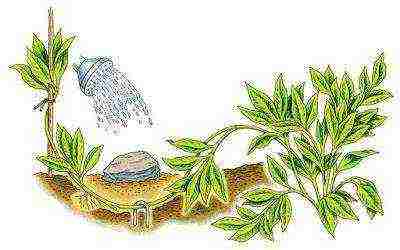
Breeding methods for sage
The plant you like can be propagated by dividing the bush, vegetatively and by cuttings.
The best time to divide the bush is spring. After the emergence of young shoots, you need to dig up the sage bush and carefully divide it. If you can't do it with your hands, you can take a sharpened shovel and quickly divide the bush into two (or more) parts. The division can also be carried out with disinfected pruners, cutting the root system into pieces.
For vegetative propagation at the beginning of summer, you need to carefully bend a strong shoot to the ground, pin it with a bracket, and sprinkle it with earth. Make sure that the ground covers the bracket. After two months, a developed root system will allow the separation of the new plant from the mother plant.
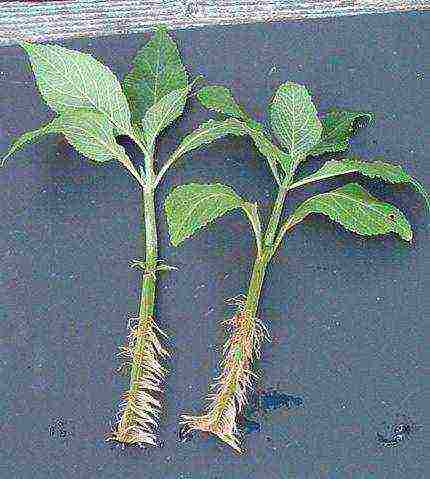
For grafting, you need to cut off a strong shoot with a blade or scalpel, leave four buds on it. On the upper ones, keep the leaves intact, the fourth goes into the soil. Root in a prepared light planting mixture of humus and perlite to a depth of 8-10 cm, placing the shoot obliquely. Shed. Create a mini-greenhouse by covering the container with the handle with a film. Moisten as needed, ventilate. After a month, the stalk will give good roots.
When planting the plant in the ground, it is not necessary to tighten it, since the sage should take root well by autumn.
Sage in the country: two ways of planting and care
 The Mediterranean has brought us a very beautiful and healing sage plant. There is nothing difficult in growing it, while its decorativeness will delight the eye all summer. Sage leaves are anti-inflammatory and bactericidal, so you will always have a natural bactericidal patch at your fingertips.
The Mediterranean has brought us a very beautiful and healing sage plant. There is nothing difficult in growing it, while its decorativeness will delight the eye all summer. Sage leaves are anti-inflammatory and bactericidal, so you will always have a natural bactericidal patch at your fingertips.
Types of sage planting
For the miraculous grass, choose an area for planting in an open area, light partial shade is allowed. The soil is loamy nutritious, the acidity level is pH 6.5-7.0, neutral. Sand is added to the clay soil. Sage prefers warmth and moisture.
Sage seeds you can buy it in the store, sow it directly in the open ground or grow it through seedlings. An adult sage bush can be transplanted.
Sage is planted in the spring, but the preparation of the beds is in the fall, or before winter. The best precursors are potatoes, onions, cabbage, or legumes. In the fall, the site is dug up, covering up humus or compost, with the addition of potassium-phosphorus fertilizer. In the spring (March-April), the soil is loosened, nitrogen fertilizer is added. If you forgot about planting sage, then in May you can still fix everything, but then no shelter is required. The seeds are soaked for a day in the Epin growth stimulator, dry, and put in the grooves to a depth of 1-2 cm, keeping the distance between the seeds 20-30 cm. The row spacing is 40-50 cm.The crops are covered with foil and the shelter is removed in stable warm weather, when the threat of frost has passed.
If sage is planted before winter, then in early October-mid-November, depending on the region, the seeds are laid in the soil to a depth of 4-5 cm, maintaining a distance of 20 cm, and between rows - 50 cm.It is very important to ensure that the seeds do not germinate , otherwise cold and frost will lead the seedlings to death. In the spring, after the emergence of seedlings, thinning and possible transplantation are carried out.
Seedling method of growing sage allows you to accelerate flowering, since planting in open ground does not take place with seeds, but with ready-made seedlings in late April-early May. For this, the seeds are germinated and the hatched seeds are transplanted into a light substrate. 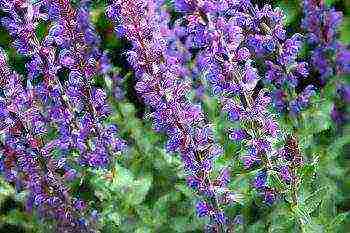 After 10-14 days, seedlings will begin to appear, after another 7-10 days, a pick is carried out, preferably in peat pots. Sage seeds can be immediately planted in peat tablets, which will save you time and make your transplanting easier. They are transplanted into open ground in stable warm weather. The distance between the bushes is 70-90 cm, since the growth is more in width than in height.
After 10-14 days, seedlings will begin to appear, after another 7-10 days, a pick is carried out, preferably in peat pots. Sage seeds can be immediately planted in peat tablets, which will save you time and make your transplanting easier. They are transplanted into open ground in stable warm weather. The distance between the bushes is 70-90 cm, since the growth is more in width than in height.
The easiest way to breed sage is to dig the lowest twig to the ground. After a while, roots will appear and after complete rooting (1.5-2 months), the young plant is carefully cut off from the mother bush and transplanted to a permanent place.
Sage is a cross-pollinated plant and when grown in several varieties, they need to be planted in different locations to maintain varietal characteristics.
Sage care
The plant is so unpretentious that it can withstand both drought and poor soil, but under such conditions decorativeness and the level of medicinal properties are reduced. This can be avoided by adhering to the basic rules of sage care. 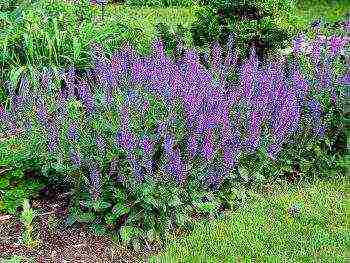
In order for the leaves to gain healing properties, and the flowers "burn" in the sun with their purple color, it is necessary to create favorable conditions for this. Regular watering and loosening from the formation of a hard crust, weeding from weeds are mandatory work in caring for sage. Without watering, the leaves become tough, and its excess will attract snails, spider mites, thrips and slugs. Thinning young shoots will allow the bushes to develop well, there will be enough light and air. Scatter small pebbles under the sage to help retain moisture and protect against weed growth. Organic mulching will retain moisture more and longer, but we don't need it. If pests appear, they are sprayed with infusion of onion peels.
For the winter, sage is covered with leaves, straw, or branches. The first few years, pruning of shoots is carried out in the fall to strengthen the root system, then the procedure is transferred to the spring. Pruning is sanitary and rejuvenating, leaving only 10 cm of shoot length from the soil surface.
After 4-5 years, the sage bushes must be replaced and another area for planting should be allocated. Subject to annual rejuvenation, the replacement period is extended to 10 years.
In harsh winters, sage may not survive wintering, then the plant will have to be grown as an annual.
When to harvest sage
Sage leaves are used dried and fresh, and are used for various purposes, as a spice for salads and side dishes, for preparing infusions and decoctions. You can collect leaves all summer, during the flowering period. Spread out in a thin layer at a temperature not higher than + 35 ° С, in the shade. Dried sage can be stored for up to a year, without losing its medicinal properties, fresh leaves - only 7 days at a temperature of 1-3 ° C. Store dried leaves in a tight paper bag. Separate the buds and stems from the leaves.
Of the most popular sage widows, we single out: from the medicinal "Nectar", "Aibolit", "Breeze"; from the meadow species "Sticky", "Forest". Interesting for their aroma and appearance: Greek, purple, tricolor, golden. All of them are registered in the State Register of the Russian Federation.
Sage, aka salvia, is another excellent representative of ornamental and medicinal plants.It belongs to the glorious genus of lamines, which gave rise to many beautiful and useful flowers. I love its beautiful, narrow foliage and blue flowers. After articles by one author about sage, I wanted to learn as much as possible about such a familiar and beautiful plant. It turned out that the shapes and colors of sage are different: from the usual to the most outlandish and extraordinary. There are 700 different sage species in the world.

Sage is a perennial, but there are both annual and biennial species. Sage inflorescences are collected in panicles or spikelets. Stems are erect, can branch and reach a length of 120 cm.
Sage is an excellent helper in cooking and medicine. In ancient Rome, it was used in the treatment of many diseases, today it is just as relevant.
Planting sage
Most species of salvia officinalis like soils of normal acidity (5.5-6.5 pH). Plant the sage in a well-lit area. It will grow better on light, fertile soils. Loamy soils are well suited for this.
To enrich the soil before planting sage, humus or compost, as well as phosphorus-potassium fertilizers, are introduced in the fall for digging. At the onset of spring, the soil is leveled and broken with a rake, after which nitrogen fertilizers are also introduced.
Sage has been growing in its place for over 8 years. This culture grows well, so the seedling method can not be used, but sow seeds directly into the ground in early spring (March - early April, using film) or in the fall under the snow. It does not matter if you are delayed with planting, you can sow in May, then a film shelter for seedlings is not needed. At the same time, stratification and any other measures for germinating seeds are not required. You can arrange a ridge for sage, make a groove and seal the seeds to a depth of no more than 2 cm.Sage grows as a bush, so it is better to leave about 30 cm between the plants, and take about 50 cm between the rows.
It is not worth sowing sage after relatives from the lamb family. The precursors of sage can be potatoes, cabbage, onions, legumes.
Sage care
Pruning. In the second year after planting, like many spicy herbs with dense inflorescences, sage is renewed by cutting (10 cm from the soil surface).
Watering. Sage tolerates drought well, but it needs moisture to keep the greens juicy and tender. Otherwise, the leaves will simply become very tough. But it is not worth pouring, he does not like this.
Fertilization. In the spring before flowering, fertilizing with nitrogen mineral fertilizers is carried out, in the fall, after the plant is cut off and prepares for winter, many gardeners carry out fertilizing with phosphorus-potassium fertilizers in accordance with the norms on the package.
Sage picking
It is customary to use and harvest sage during its flowering period. The leaves can be eaten fresh, or they can be harvested for the winter, in bunches or spread out in a dark, warm, ventilated place (in the attic).
Sage species
After the studies carried out by the Novosibirsk Research Station, 12 species resistant to steppe conditions were selected. But they turned out to be so different in their characteristics that they were divided into three groups:
1. Plants of American origin were identified in this group, their habitual environment is subtropics. In their natural environment, such plants live for several years. In the middle lane in winter, the plant dies, therefore it is cultivated as an annual. At least 100 days will pass from germination to flowering. Therefore, the sage of this group is grown mainly by seedlings.
2. This group already includes varieties of Mediterranean sage. In their natural environment, they are perennial, but in our middle lane in the open field they will die in winter, so they have to be grown as annual plants. But it will take about 40 days from germination to flowering. This suggests that you can do without seedlings.
3. The most popular group with us.This group includes sage varieties that winter well in our open field. They are perennials in the temperate zone. This group also includes the Ethiopian sage, which is cultivated as a biennial. The most unaffected studies are Muscat, Marsh and Lavender Salvia.
I would also like to share with the reader photographs of different types of sage.
Salvia sticky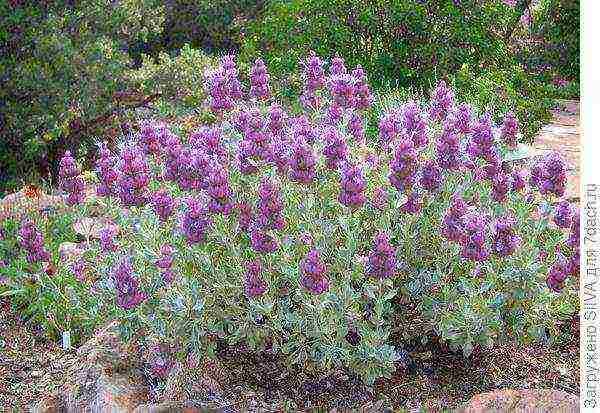
Salvia viridis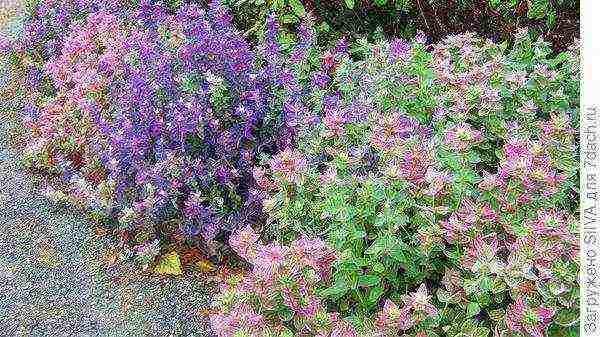

Salvia microphylla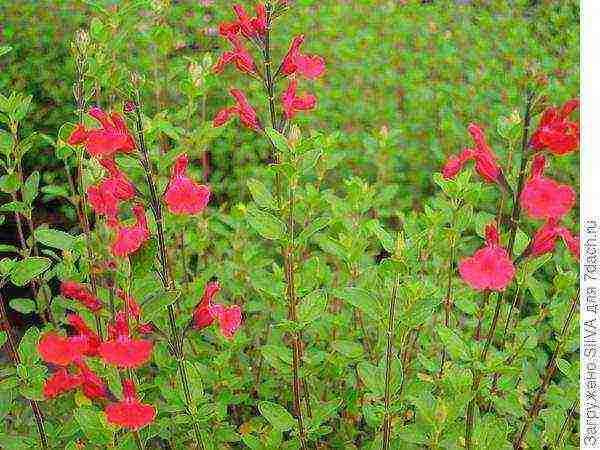
Salvia dolomitica

Sage varieties
Since this article mostly dealt with medicinal sage (vegetable), we will consider varieties that are suitable for different climatic zones and have excellent taste and irreplaceable medicinal properties.
Sage Breeze This variety is included in the State Register of the Russian Federation, it is recommended for consumption fresh and dried (young shoots and foliage), it is used for the preparation of desserts, salads, soups, sauces, meat, fish. Plants of this variety reach about 60 cm in height, with erect shoots and dense foliage. The leaves are pubescent, toothed at the edges. In the second year after planting, the bush of the variety reaches about 280 g. Flowers are violet-blue in color. Seeds are small, brown-black in color.
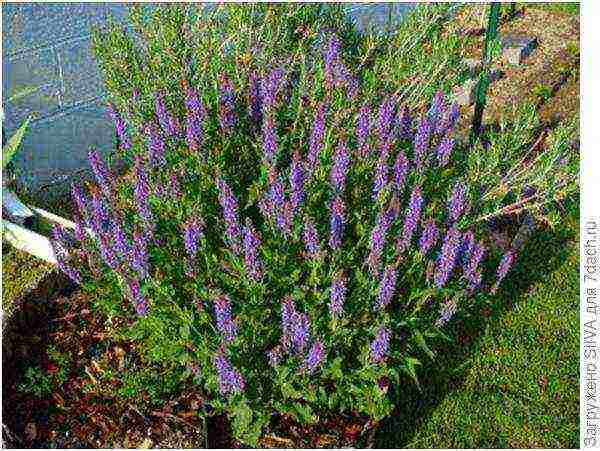
Sage Aibolit Like the previous variety, it is included in the State Register of the Russian Federation. It is consumed both fresh and dry. The plant is larger than the previous one, 60-120 cm tall. The leaf is dark green, finely toothed along the edge, wrinkled, has strong pubescence. It is customary to use the variety in the second year after planting, after a month from the beginning of the growing season. But it is not as persistent in winter as the previous variety, so in the middle lane it is better to cover it for the winter.

Sage Nectar The variety, included in the State Register of the Russian Federation, is very popular when combined with cheese and in aromatic culinary compositions. Its height is about 100 cm, the stem is erect. Foliage color is light green with pubescence. The flowers are blue-violet.

Sage Patriarch Semko The variety is used dry and fresh; it has been included in the State Register since 2000. The height of this variety is 50-80 cm. Erect, stiff stems at the bottom. Dense foliage up to 10 cm long. At the top of the shoot, the leaves are smaller. The seeds are in the form of a ball, the flowers are blue-violet.
I also recommend another author's excellent article on this wonderful plant.


